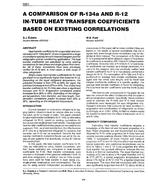
3331 — A Comparison of R-134a and R-12 In-Tube Heat Transfer Coefficients Based on Existing Correlations
- Comments Off on 3331 — A Comparison of R-134a and R-12 In-Tube Heat Transfer Coefficients Based on Existing Correlations
- ASHRAE
Heat transfer coefficients for evaporation and condensation of R134a and R12 are compared for a range of conditions typically found in heat exchangers used for refrigeration and air-conditioning applications. The heat transfer coefficients are calculated by using existing correlations for two-phase and single-phase heat transfer. All of these correlations have been previously verified for R12 and, in most cases, a wide range of other refrigerants. Single-phase heat transfer coefficients for R134a are shown to be significantly higher than those for R12. Depending on the liquid refrigerant temperature, the predicted increase is from 27% to 38%, for vapour the predicted increase is from 37% to 45%. Two-phase heat transfer coefficients for R134a also show a significant increase over R12. Evaporation correlations predict increases from 28% to 40%, depending on the refrigerant temperature, tube diameter, and tube length. Condensation correlations predict increases from 33% to 38%, depending on the refrigerant temperature.
KEYWORDS: calculating, comparing, heat transfer coefficient, heat flow, R134a, R12, heat exchangers, refrigeration, air conditioning, statistics, refrigerants.
Citation: ASHRAE Transactions, vol.96, pt. 1, Atlanta, 1990
Product Details
- Published:
- 1990
- Number of Pages:
- 10
- File Size:
- 1 file , 1.2 MB
- Product Code(s):
- D-18400

